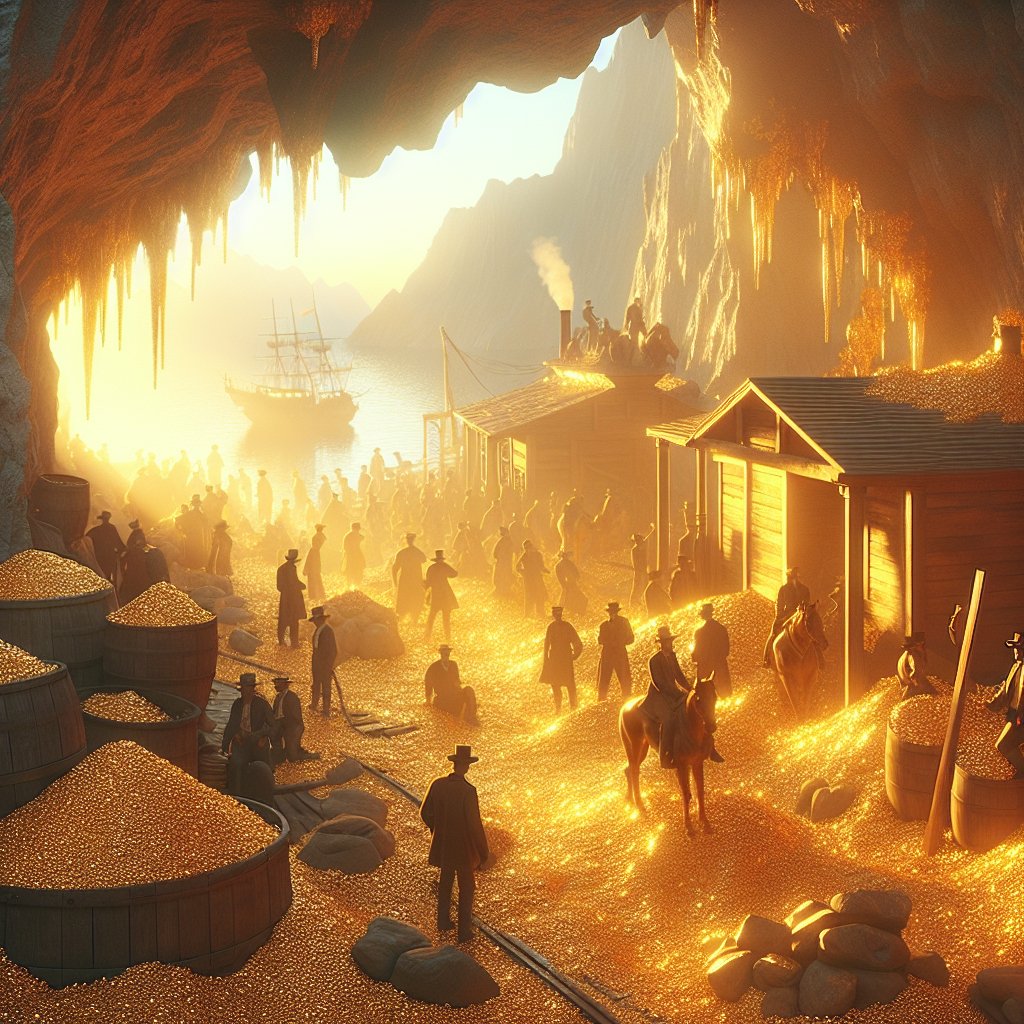The allure of gold has captivated human societies for centuries, driving individuals and nations alike to embark on perilous journeys and engage in fierce competition. The history of gold rushes offers a fascinating glimpse into the depths of human greed and ambition, revealing how the pursuit of this precious metal has shaped economies, cultures, and landscapes. From the legendary California Gold Rush to the lesser-known but equally impactful Klondike Gold Rush, these events have left an indelible mark on history, providing valuable lessons about human nature and the relentless quest for wealth.
The California Gold Rush: A Catalyst for Change
The California Gold Rush of 1848-1855 stands as one of the most significant events in American history, marking a period of rapid economic growth and social transformation. The discovery of gold at Sutter’s Mill by James W. Marshall in January 1848 set off a frenzy that attracted hundreds of thousands of prospectors, known as “forty-niners,” from around the world. This mass migration not only accelerated California’s admission to the Union as the 31st state but also had profound implications for the United States as a whole.
The influx of gold-seekers led to the rapid development of infrastructure, including roads, railways, and ports, facilitating the movement of people and goods across the continent. San Francisco, once a small settlement, quickly transformed into a bustling metropolis, becoming the financial and cultural hub of the West Coast. The economic boom fueled by the gold rush also contributed to the expansion of industries such as banking, shipping, and manufacturing, laying the groundwork for America’s emergence as a global economic power.
However, the California Gold Rush also exposed the darker side of human greed. The insatiable desire for wealth led to the exploitation of natural resources, resulting in significant environmental degradation. Rivers were dammed, forests were cleared, and landscapes were scarred by mining operations, leaving a lasting impact on the region’s ecology. Additionally, the gold rush exacerbated tensions between settlers and Native American populations, leading to violent conflicts and the displacement of indigenous communities.
The Klondike Gold Rush: A Tale of Hardship and Resilience
While the California Gold Rush is perhaps the most famous, the Klondike Gold Rush of 1896-1899 offers another compelling chapter in the history of gold fever. Located in the remote Yukon Territory of Canada, the Klondike region became the epicenter of a new gold rush following the discovery of gold in Bonanza Creek by George Carmack, Skookum Jim, and Tagish Charlie in August 1896. News of the discovery spread rapidly, sparking a stampede of prospectors eager to strike it rich.
The journey to the Klondike was fraught with peril, as prospectors faced harsh weather conditions, treacherous terrain, and the constant threat of starvation. Many hopeful miners embarked on the arduous trek over the Chilkoot or White Pass trails, enduring grueling climbs and bitter cold to reach the goldfields. Despite the challenges, the promise of untold wealth drove an estimated 100,000 people to attempt the journey, though only around 30,000 ultimately reached the Klondike.
The Klondike Gold Rush highlighted the resilience and determination of those who sought fortune in the face of adversity. While some prospectors struck it rich, the majority found little more than hardship and disappointment. The harsh realities of the goldfields underscored the unpredictability of gold mining and the often elusive nature of wealth. Yet, the rush also fostered a sense of camaraderie and community among the miners, who banded together to survive the harsh conditions and support one another in their quest for gold.
As with the California Gold Rush, the Klondike Gold Rush had significant environmental and social impacts. The influx of prospectors led to the rapid development of towns such as Dawson City, which became a bustling center of commerce and culture. However, the environmental toll was considerable, with deforestation, soil erosion, and water pollution resulting from mining activities. The rush also disrupted the lives of indigenous peoples in the region, as traditional lands were encroached upon and resources were depleted.
Lessons from History: The Dual Nature of Gold Rushes
The history of gold rushes offers valuable insights into the dual nature of human ambition and greed. On one hand, these events have driven economic growth, innovation, and the expansion of frontiers, contributing to the development of modern societies. The infrastructure and industries established during gold rushes have had lasting benefits, facilitating trade, communication, and cultural exchange.
On the other hand, gold rushes have often been accompanied by environmental destruction, social upheaval, and the exploitation of vulnerable populations. The relentless pursuit of wealth has led to the depletion of natural resources, the displacement of indigenous communities, and the perpetuation of inequality and injustice. These negative consequences serve as a cautionary tale, reminding us of the need to balance economic ambition with environmental stewardship and social responsibility.
In reflecting on the history of gold rushes, it is essential to recognize the complex interplay between human greed and the quest for progress. While the pursuit of gold has driven remarkable achievements, it has also revealed the darker aspects of human nature. By learning from the past, we can strive to create a more equitable and sustainable future, where the pursuit of wealth is tempered by a commitment to the well-being of people and the planet.
The Modern Gold Market: Echoes of the Past
Today, the global gold market continues to be influenced by the same forces that drove historical gold rushes. The price of gold is shaped by a myriad of factors, including economic uncertainty, geopolitical tensions, and shifts in supply and demand. As a safe-haven asset, gold remains a popular investment choice during times of financial instability, reflecting the enduring allure of this precious metal.
However, the modern gold market also faces challenges reminiscent of those encountered during historical gold rushes. Environmental concerns, such as the impact of mining on ecosystems and the carbon footprint of gold production, are increasingly coming to the forefront. Additionally, issues related to labor rights and the ethical sourcing of gold have prompted calls for greater transparency and accountability within the industry.
As we navigate the complexities of the modern gold market, the lessons of history serve as a valuable guide. By acknowledging the dual nature of gold rushes and the consequences of unchecked greed, we can work towards a more sustainable and equitable approach to gold production and consumption. In doing so, we honor the legacy of those who sought fortune in the past while paving the way for a brighter future.












